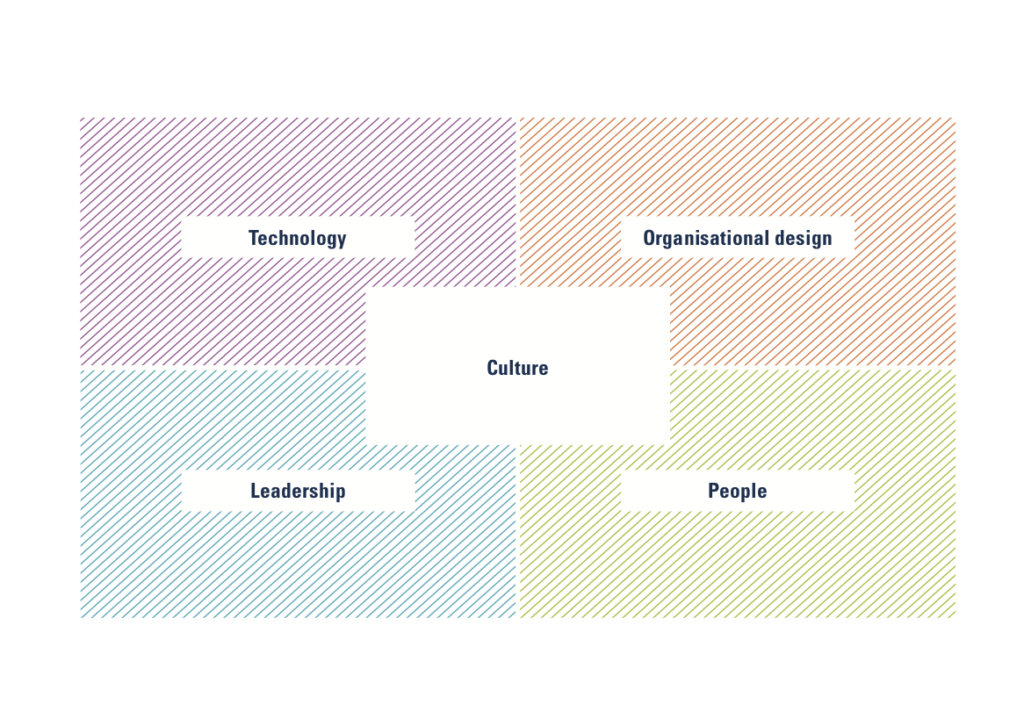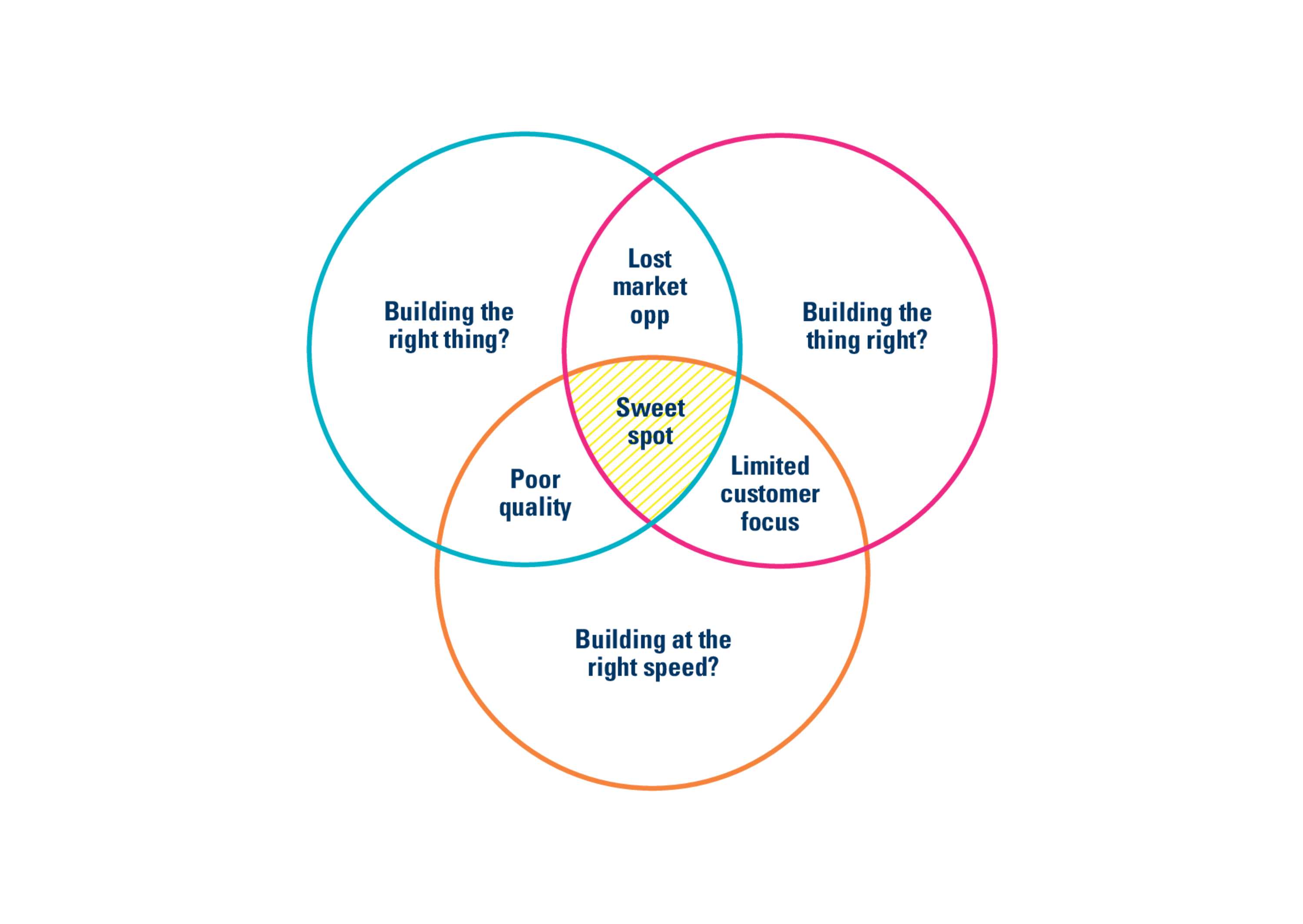
The five key drivers for a company to get ahead
Companies are facing major, far-reaching changes, particularly in the financial services sector. How can companies not only survive these changes, but also use them to their advantage and strengthen their market position?
More efficiency does not help here. Doing the wrong thing faster does not bring about market success. The market, competitors and new technologies are developing so rapidly that companies really need to become more dynamic and adaptable – in other words, more agile.
Business agility enables companies to react to changes quickly, effectively and with controlled risk. With experience and skills in this domain, the changes can also be actively shaped.
It is important that companies move away from the illusion of predictability. By definition, complex problems cannot be solved by means of planning in advance. All approaches that promise to do so give a false sense of security.
How do companies now achieve this ominous business agility?
According to Jorgen Hesselberg (Unlocking Agillity – 2019), business agility comprises five dimensions:
- 1 – Technology
A company requires technological tools to be able to work in an agile manner. These include collaboration tools that facilitate cooperation. However, know-how and expertise are much more important in agile work. This includes concepts such as lean startup, scrum, business model canvas, design thinking, etc. This knowledge must be established and anchored in the organisation, almost becoming part of its DNA. - 2 – Organisational structure
The key issue of this dimension is whether the structures of a company make cooperation easier or more difficult. Part of organisational structures is the physical framework of an organisation, for example, work premises. Simple cooperation in a team requires, for example, creative spaces as well as team, meeting and focus zones. However, the management structure is at least as important. Steep hierarchies and a silo mentality result in local optimisations, which attach greater importance to the interests of one area than to the entire organisation. The focus of the organisational structure should be on creating added value for clients. - 3 – People
In a world full of volatility, uncertainty, complexity, and ambiguity (VUCA), organisations need committed, creative and talented employees. It is obvious that we will only win in this ‘war for talent’ if we grant employees the extensive freedom they need to fulfil their tasks. We must take this fact into account when creating incentives (remuneration, bonuses, promotions, etc.): cooperation in teams and creativity should be fostered. - 4 – Management
Companies also need a paradigm shift regarding management. While organisations once sought the ‘single best way’ (Taylorism), today we require the creativity and expertise of all employees to solve complex problems quickly and well. The task of managers is therefore no longer the ‘heroic commanding of troops’, but rather to define the framework in which the organisation and its employees can develop. - 5 – Culture
What primarily constitutes an agile organisation is its capacity to learn: it needs to be in a position to identify errors quickly, draw the right conclusions from them and adapt accordingly. This presupposes that we see changes not as a threat, but as an opportunity, which, in turn, requires the courage to try out new things.
Finnova has been on the journey to greater business agility for seven years. Many steps have been taken during this time. We have been able to develop for the better, and have used the experience gained to become more dynamic and focused. For example, Finnova includes its customers much more in the product development than before. This is possible because customers are also increasingly concerned with agility and both sides see the value of close cooperation. Where we were previously simply the supplier of ordered features as a software manufacturer, we are now a partner. And where our customers used to simply be ordering parties, they are now partners. The roles have been adapted. Common experiences lead to a better understanding of our counterparts, their views and expectations, and improve partnership. The complexity of the tasks has remained the same, but the approach, solutions and communication have changed.
Major changes are required in companies to enable them to develop in all dimensions of business agility. This requires perseverance and courage. In the end, however, there is no alternative for an organisation that wants to be future-proof. Or, to express it in the words of the management thinker W. Edwards Deming: « It is not necessary to change. Survival is not mandatory. »

by Ari Byland
Head of Transformation & Lean Portfolio
Finnova AG

Market success sets in when the right product with the right quality is available at the right time
‘Building the right thing’: Products must primarily meet a customer need, in a way that is economically useful for the company. If this requirement is not met, the product will inevitably disappear from the market sooner or later.
‘Building at the right time & speed’: A product needs to be available on the market at the right time. On the one hand, this means that a product launched too late throws away market opportunities. This results in delays, because the complexity of the product development is underestimated or the company structures are not geared towards dealing with this complexity. On the other hand, a product can also be launched too early. So, for example, Netflix would not have succeeded with its streaming offer in the 90s, even if the product itself had been the same, for the simple reason that complementary factors such as fast internet connections in a sufficient number of households would have been lacking. Apple’s first tablet ‘Newton’ also came onto the market too early in the 90s for people to know what it should be used for. Today, both tablets and streaming offers are omnipresent.
‘Building the thing right’: We all know of products that promise a lot but then leave a lot to be desired when we use them or, worse still, are faulty. We are frustrated with these products and we do not recommend them. Market success is absent and they disappear from the market.
Source: Hesselberg, Jorgen (2019): Unlocking Agility
